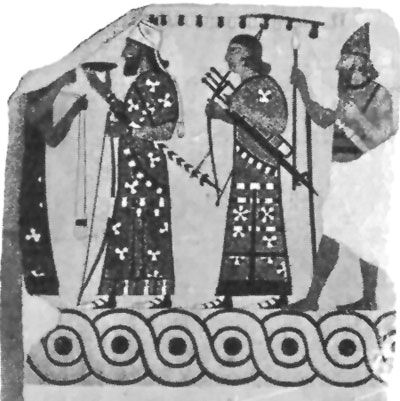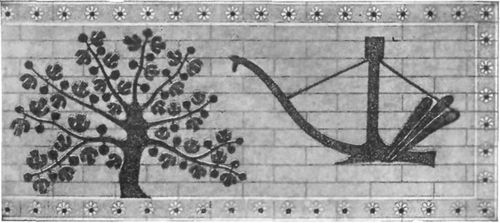








Books Recommended: Babelon, Manual of Oriental Antiquities; Botta, Monument de Ninive; Budge, Babylonian Life and History; Duncker, History of Antiquity; Layard, Nineveh and its Remains; Layard, Discoveries Among Ruins of Nineveh and Babylon; Lenormant, Manual of the Ancient History of the East; Loftus, Travels in Chaldæa and Susiana; Maspero, Life in Ancient Egypt and Assyria; Perrot and Chipiez, History of Art in Chaldæa and Assyria; Place, Ninive et l'Assyrie; Sayce, Assyria: Its Palaces, Priests, and People.
TIGRIS-EUPHRATES CIVILIZATION: In many respects the civilization along the Tigris-Euphrates was like that along the Nile. Both valleys were settled by primitive peoples, who grew rapidly by virtue of favorable climate and soil, and eventually developed into great nations headed by kings absolute in power. The king was the state in Egypt, and in Assyria the monarch was even more dominant and absolute. For the Pharaohs shared architecture, painting, and sculpture with the gods; but the Sargonids seem to have arrogated the most of these things to themselves alone.
Religion was perhaps as real in Assyria as in Egypt, but it was less apparent in art. Certain genii, called gods or demons, appear in the bas-reliefs, but it is not yet settled whether they represent gods or merely legendary heroes or monsters of fable. There was no great demonstration of religion by form and color, as in Egypt. The Assyrians were Semites, and religion with them was more a matter of the spirit than the senses—an image in the mind rather than an image in metal or stone. The temple was not eloquent with the actions and deeds of the gods, and even the tomb, that fruitful source of art in Egypt, was in Chaldæa undecorated and in Assyria unknown. No one knows what the Assyrians did with their dead, unless they carried them back to the fatherland of the race, the Persian Gulf region, as the native tribes of Mesopotamia do to this day.
 FIG. 5.—ENAMELLED BRICK. NIMROUD.
FIG. 5.—ENAMELLED BRICK. NIMROUD.ART MOTIVES: As in Egypt, there were two motives for art—illustration and decoration. Religion, as we have seen, hardly obtained at all. The king attracted the greatest attention. The countless bas-reliefs, cut on soft stone slabs, were pages from the history of the monarch in peace and war, in council, in the chase, or in processional rites. Beside him and around him his officers came in for a share of the background glory. Occasionally the common people had representations of their lives and their pursuits, but the main subject of all the valley art was the king and his doings. Sculpture and painting were largely illustrations accompanying a history written in the ever-present cuneiform characters.
But, while serving as history, like the picture-writings of the Egyptians, this illustration was likewise decoration, and was designed with that end in view. Rows upon rows of partly colored bas-reliefs were arranged like a dado along the palace-wall, and above them wall-paintings, or glazed tiles in patterns, carried out the color scheme. Almost all of the color has now disappeared, but it must have beenbrilliant at one time, and was doubtless in harmony with the architecture. Both painting and sculpture were subordinate to and dependent upon architecture. Palace-building was the chief pursuit, and the other arts were called in mainly as adjuncts—ornamental records of the king who built.

THE TYPE, FORM, COLOR: There were only two distinct faces in Assyrian art—one with and one without a beard. Neither of them was a portrait except as attributes or inscriptions designated. The type was unendingly repeated. Women appeared in only one or two isolated cases, and even these are doubtful. The warrior, a strong, coarse-membered, heavily muscled creation, with a heavy, expressionless, Semitic face, appeared everywhere. The figure was placed in profile, with eye and bust twisted to show the front view, and the long feet projected one beyond the other, as in the Nile pictures. This was the Assyrian ideal of strength, dignity, and majesty, established probably in the early ages, and repeated for centuries with few characteristic variations. The figure was usually given in motion, walking, or riding, and had little of that grace seen in Egyptian painting, but in its place a great deal of rude strength. In modelling, the human form was not so knowingly rendered as the animal. The long Eastern clothing probably prevented the close study of the figure. This failure in anatomical exactness was balanced in part by minute details in the dress and accessories, productive of a rich ornamental effect.
Hard stone was not found in the Mesopotamian regions. Temples were built of burnt brick, bas-reliefs were made upon alabaster slabs and heightened by coloring, and painting was largely upon tiles, with mineral paints, afterward glazed by fire. These glazed brick or tiles, with figured designs, were fixed upon the walls, arches, and archivolts by bitumen mortar, and made up the first mosaics of which we have record. There was a further painting upon plaster in distemper, of which some few traces remain. It did not differ in design from the bas-reliefs or the tile mosaics.
The subjects used were the Assyrian type, shown somewhat slighter in painting than in sculpture, animals, birds, and other objects; but they were obviously not attempts at nature. The color was arbitrary, not natural, and there was little perspective, light-and-shade, or relief. Heavy outline bands of color appeared about the object, and the prevailing hues were yellow and blue. There was perhaps less symbolism and more direct representation in Assyria than in Egypt. There was also more feeling for perspective and space, as shown in such objects as water and in the mountain landscapes of the late bas-reliefs; but, in the main, there was no advance upon Egypt. There was a difference which was not necessarily a development. Painting, as we know the art to-day, was not practised in Chaldæa-Assyria. It was never free from a servitude to architecture and sculpture; it was hampered by conventionalities; and the painter was more artisan than artist, having little freedom or individuality.

HISTORIC PERIODS: Chaldæa, of unknown antiquity, with Babylon its capital, is accounted the oldest nation in the Tigris-Euphrates valley, and, so far as is known, it was an original nation producing an original art. Its sculpture (especially in the Tello heads), and presumably its painting, were more realistic and individual than any other in the valley. Assyria coming later, and the heir of Chaldæa, was the
Second Empire: There are two distinct periods of this Second Empire, the first lasting from 1,400 B.C., down to about 900 B.C., and in art showing a great profusion of bas-reliefs. The second closed about 625 B.C., and in art produced much glazed-tile work and a more elaborate sculpture and painting. After this the Chaldæan provinces gained the ascendency again, and Babylon, under Nebuchadnezzar, became the first city of Asia. But the new Babylon did not last long. It fell before Cyrus and the Persians 536 B.C. Again, as in Egypt, the earliest art appears the purest and the simplest, and the years of Chaldæo-Assyrian history known to us carry a record of change rather than of progress in art.
ART REMAINS: The most valuable collections of Chaldæo-Assyrian art are to be found in the Louvre and the British Museum. The other large museums of Europe have collections in this department, but all of them combined are little compared with the treasures that still lie buried in the mounds of the Tigris-Euphrates valley. Excavations have been made at Mugheir, Warka, Khorsabad, Kouyunjik, and elsewhere, but many difficulties have thus far rendered systematic work impossible. The complete history of Chaldæo-Assyria and its art has yet to be written.